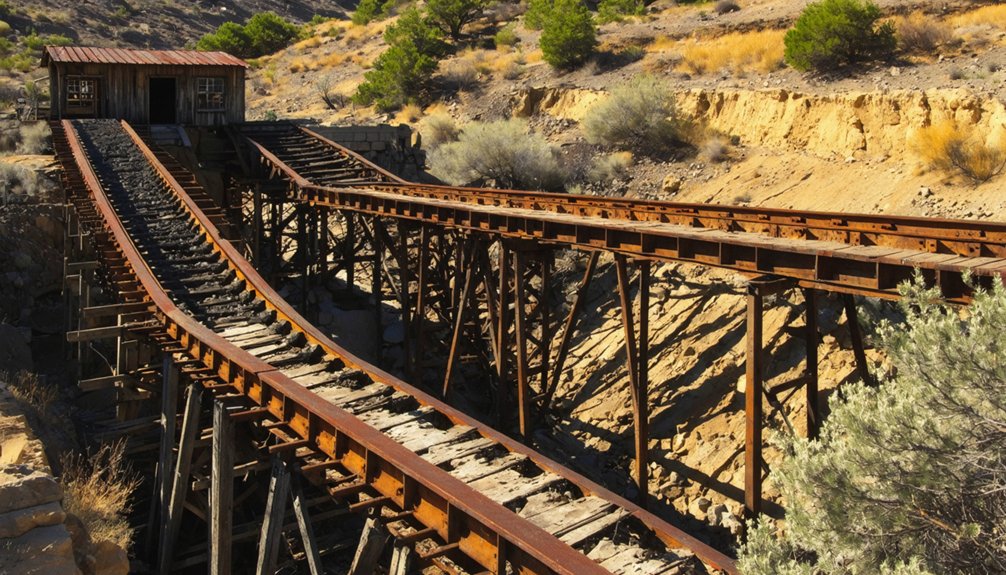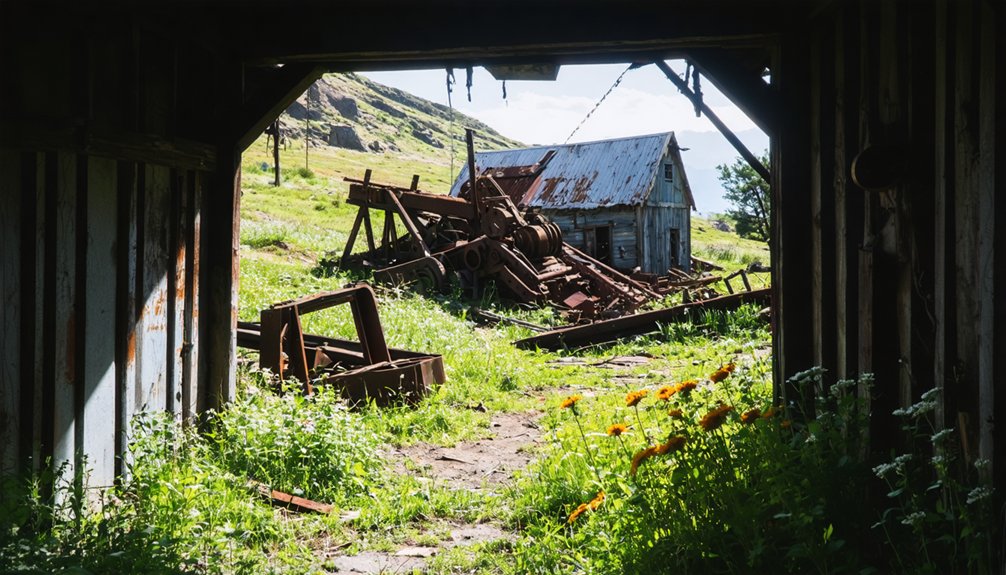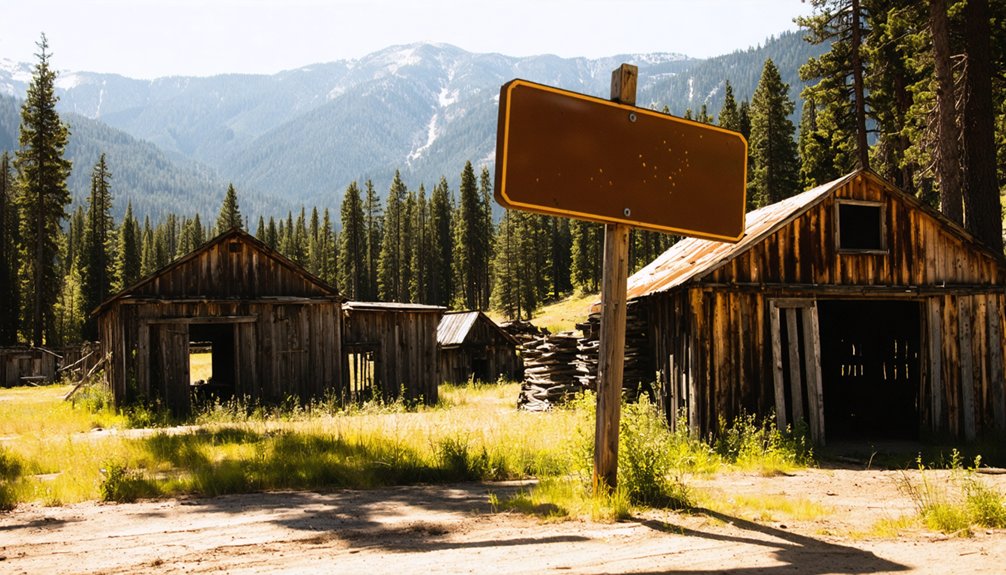You’ll find You Bet tucked in Nevada County’s Sierra Nevada foothills—a ghost town named after a Gold Rush saloon keeper’s favorite phrase. This hydraulic mining settlement boomed in the 1850s when Browns Hill Mines extracted about $1 million in gold. The 1884 Sawyer Decision halted operations, leading to abandonment. Today, you’ll see scattered ruins, rusted equipment, and overgrown paths—silent witnesses to California’s golden era that hold stories waiting to be uncovered.
Key Takeaways
- You Bet was founded in the 1850s as a Gold Rush mining town, named after a popular phrase at a local miners’ bar.
- The town flourished through hydraulic mining until the 1884 Sawyer Decision prohibited the practice, causing economic collapse.
- Now a ghost town, You Bet features abandoned structures, rusted mining equipment, and overgrown paths reclaimed by vegetation.
- Daily life centered around mining operations, with saloons serving as social hubs and families living in single-room cabins.
- Notable residents included Lazarus Beard, the saloon keeper who inspired the town’s name, and Chinese miners who operated until the 1930s.
The Peculiar Naming of a Gold Rush Settlement
How did a casual expression become the name of an entire California settlement? The story begins in the 1850s at a popular miners’ bar where “You bet!” echoed as the preferred response to virtually any question. This phrase became so synonymous with the establishment that locals naturally adopted it for town naming purposes.
Unlike more formal settlements named after dignitaries or geographic features, You Bet reflects the spontaneous, colloquial culture that defined Gold Rush communities. The name appears in maps and mining records from the period, confirming its official adoption despite its unconventional origin. By 1858, the area had transitioned from a transient mining camp to a permanent town with established infrastructure.
This distinctive name carries significant cultural significance, demonstrating how everyday language shaped frontier identity. The gold rush brought approximately 300,000 people to California, creating numerous similar makeshift communities throughout the region. You Bet stands as a linguistic time capsule of mining-era informality and communal decision-making.
Mining Prosperity and Economic Peak Years
You’d have witnessed tremendous economic prosperity in You Bet during the late 1800s through early 1900s when hydraulic mining operations reached their zenith.
Browns Hill Mines generated substantially more wealth than neighboring Red Dog’s operations, attracting merchants who established shops catering to the diverse mining workforce that included significant numbers of Chinese laborers.
The settlement’s commercial activity flourished around the extraction of approximately $1 million from the Little York Diggings alone, creating a bustling hub that reflected the region’s gold-fueled economic boom. Unlike Empire Mine which yielded nearly 6 million troy ounces of gold during its operation, You Bet’s production was more modest but still significant to California’s mining history. The hydraulic mining operations were eventually curtailed in the mid-1880s due to legal restrictions imposed by the Sawyer Decision.
Gold Rush Wealth
When gold was discovered at Sutter’s Mill in 1848, few could have predicted the unprecedented wealth that would flow from California’s hills and streams. By 1855, annual gold production peaked at a staggering $60 million—equivalent to $2.1 billion today.
Between 1848 and 1855, miners extracted approximately 125 million troy ounces, valued at $200 billion in contemporary dollars.
The gold rush economy transformed California virtually overnight. San Francisco’s port handled $2 billion in gold shipments by 1854, becoming the West Coast’s busiest harbor. The Bank of California emerged to centralize gold transactions and introduce standardized currency throughout the region. The economic shock of the Gold Rush led to a sharp increase in real wages across California during the early years.
While individual prospectors initially struck it rich, merchants ultimately accumulated the greatest fortunes. Companies like Levi Strauss generated millions meeting miners’ needs, while Samuel Brannan became California’s wealthiest man by controlling the supply chain.
This mining legacy established the foundation for California’s economic dominance that continues today.
Hydraulic Mining Boom
As California’s gold mining industry evolved beyond simple panning methods, hydraulic mining emerged as a revolutionary technique that would transform You Bet into a thriving boomtown.
By 1855, powerful monitors blasted high-pressure water at gold-bearing gravel banks, requiring extensive mining infrastructure of ditches, flumes, and reservoirs.
The economic impact of these hydraulic techniques was profound:
- Mining operations employed hundreds of workers, becoming You Bet’s economic backbone for over 80 years.
- Massive sluices stretched over a mile downstream to process the gold-rich gravel.
- Production reached staggering volumes—up to 100 million tons of material processed.
- Substantial gold recovery created significant local and regional wealth.
This prosperity continued until the mid-1880s when the Sawyer Decision curtailed hydraulic mining due to environmental damage, forcing miners to shift to drift mining methods. You Bet’s history of drift and hydraulic mining is extensively documented in Jerry Brady’s book, detailing both methods’ significant roles in the town’s development. Similar to Camptonville, You Bet’s destructive hydraulic mining operations dramatically altered the landscape and waterways throughout the northern Mother Lode region.
Merchants and Commerce
During the height of hydraulic mining operations, You Bet transformed from a simple mining camp into a thriving commercial center with diverse businesses catering to the needs of miners and their families.
The town’s commerce evolution directly paralleled mining productivity, with economic peaks generating over $3 million in gold that fueled local trade.
You’d find essential establishments including supply stores, general merchandise shops, blacksmiths, and saloons like the one owned by Lazarus Beard.
The busy post office connected You Bet to other Gold Rush communities while facilitating commerce. Like many mining towns, You Bet’s residents faced impoverished conditions while pursuing their fortunes through the town’s businesses. Similar to Bodie, miners’ daily wages were as low as $4 a week for dangerous underground work. Merchant relationships were particularly adaptable, with storekeepers often extending credit during lean periods and adjusting inventories to meet miners’ changing needs.
This commercial ecosystem remained vulnerable to mining’s boom-and-bust cycles, ultimately collapsing when hydraulic operations declined in the 1880s.
Daily Life in a Sierra Nevada Mining Community
You’d find the saloon at the heart of social life in mining towns like You Bet, where miners gathered after long workdays to share stories, gamble, and escape the isolation of claim life.
Families struggled with the harsh realities of Sierra Nevada living, often cramming into single-room cabins with minimal protection from brutal winter conditions and summer heat.
Children as young as ten worked alongside parents in mining operations, helping to pan for gold or sort ore while women managed households and often ran side businesses like laundries to supplement the family’s uncertain mining income.
Saloon Social Center
The bustling saloon in You Bet stood as the heartbeat of daily social life in this Sierra Nevada mining community. Owned by Lazarus Beard, whose catchphrase gave the town its unique name, this establishment served as more than just a drinking spot—it functioned as your de facto town hall where community decisions were made and local identity took shape.
After exhausting shifts, you’d join fellow miners at these saloon gatherings for:
- Card games and gambling while sharing mining news
- Impromptu entertainment with music and storytelling
- Informal business deals and job networking
- Holiday celebrations and community fundraisers
The saloon’s economic impact extended beyond its walls, providing employment and supporting local vendors.
This landmark became the symbol of You Bet’s origin story, preserving the town’s distinctive folklore and traditions even as the settlement declined.
Family Mining Struggles
While the saloon offered brief respite from daily toils, family life in You Bet centered around the harsh realities of mining survival. You’d wake before dawn, gathering your family for another grueling day. Your children helped sort gravel while your spouse maintained your makeshift cabin.
When hydraulic operations ran continuously, you’d work punishing shifts that left you bone-tired. As gold yields declined, your family faced mounting financial pressure. You’d adapt to seasonal flooding and droughts, sometimes relocating your home when environmental damage became severe.
Mercury exposure and mining accidents constantly threatened your health, while limited medical care made even minor injuries dangerous. Family cooperation became your lifeline—you’d share resources with neighbors, participate in rare community gatherings, and rely on each other when mining hardships intensified.
Your children’s education often suffered, interrupted by the constant demands of survival.
Impact of the Sawyer Decision on You Bet’s Future

After Judge Lorenzo Sawyer delivered his landmark ruling in 1884, You Bet’s future changed dramatically overnight.
The Sawyer Decision, which prohibited hydraulic mining debris from entering California’s waterways, struck a devastating blow to your town’s primary economic engine.
You’d witness four major consequences in the years following:
- Immediate economic decline as hydraulic mining operations shuttered and supporting businesses collapsed.
- Significant population shift as miners and their families abandoned You Bet for new opportunities.
- Environmental recovery of local streams and downstream agricultural lands previously choked with sediment.
- Transformation of the once-vibrant mining community into a quiet shadow of its former self.
While some residents adapted through small-scale mining or agriculture, You Bet never regained its Gold Rush prosperity, gradually fading toward ghost town status.
Notable Characters and Local Legends
During You Bet’s colorful history, several memorable characters shaped the town’s identity and left behind enduring legends. Lazarus Beard, the saloon keeper whose favorite expression gave the town its unusual name in 1857, stands prominently among these figures. His establishment became the nucleus around which miners relocated their buildings, creating the community’s center.
The saloon keeper’s favorite phrase birthed a town, with Lazarus Beard’s establishment becoming You Bet’s beating heart.
The influential miners of the Brooklyn Lodge wielded significant power in local governance while participating in the town’s vibrant social fabric.
Jerry Brady’s family preserved tales of mining adventures and frontier challenges, contributing to the rich tapestry of local legends. Meanwhile, persistent stories of an undiscovered gold lode continue to captivate treasure hunters.
Chinese miners, active into the early 20th century, maintained operations through the 1930s, proving their resilience in a community marked by rowdy saloons and dramatic fires.
What Remains: Exploring the Ghost Town Today

Today’s visitors to You Bet encounter a landscape where past and present converge in haunting stillness. The remnants of this once-bustling mining community now stand as silent witnesses to California’s gold rush era, with several original buildings persisting despite decades of exposure to the elements.
When exploring You Bet, you’ll discover:
- Abandoned structures with few intact roofs, some reduced to foundations or weathered walls
- Rusted mining equipment scattered throughout the site, telling stories of industrial ambition
- Overgrown paths and roads once busy with ore carts and miners
- Historical artifacts partially reclaimed by native vegetation
Access requires dirt roads and preparation—bring supplies as no modern amenities exist. The absence of formal preservation efforts means you’re experiencing authentic decay, untouched by commercial restoration.
You Bet’s Place in California Gold Country Heritage
A testament to California’s pioneering spirit, You Bet represents a significant chapter in the state’s gold mining legacy. Established around 1857 when miners relocated buildings to surround “Old You Bet’s Saloon,” the town exemplifies the informal governance of frontier settlements—even taking its unique name from a bartender’s catchphrase.
You Bet’s cultural heritage lies in its impressive mining operations, which produced an estimated $3 million in gold output. The town’s economic prosperity depended on hydraulic and drift mining techniques that extracted gold from placer deposits within Nevada County’s rich gravels.
Following the passage of strict mining regulations, You Bet experienced economic decline, sliding into obscurity.
Today, preservation efforts led by natives like Jerry Brady aim to commemorate this once-thriving community through historical documentation, annual tours, and monument establishment.
Frequently Asked Questions
Were Any Famous Gold Nuggets Discovered in You Bet?
You’d think famous nuggets would glitter in You Bet’s history books, but they don’t. Despite productive mining legends, no historically significant gold nuggets were specifically documented from this hydraulic mining town. Modern detectorists still find smaller pieces though.
What Natural Disasters Affected the Town Throughout Its History?
You’ll find little evidence of major natural disasters in historical records. No documented earthquake impacts or significant flood damage affected You Bet throughout its mining history and decline.
How Did Children Receive Education in You Bet?
You’d think mining kids missed out on learning, but they didn’t. Your children attended one-room schoolhouses in You Bet with local teachers providing education as the town established its first public school early on.
Were There Conflicts With Native American Tribes in the Area?
Yes, you’d witness severe conflicts as miners displaced Nisenan people from their ancestral lands. Despite no formal historical treaties, tribal relations deteriorated through violence, disease, and destruction of indigenous food sources.
What Transportation Methods Connected You Bet to Neighboring Communities?
You’d find stagecoach routes, particularly Henness Pass Road, connecting You Bet to neighboring settlements. Placer mining trails, local road networks, and later railroad expansion gradually replaced primitive wagon routes during the Gold Rush era.
References
- https://dornsife.usc.edu/magazine/echoes-in-the-dust/
- https://nevadacountyhistory.org/product/you-bet-california-gold-fever/
- https://nevadacountylandmarks.wordpress.com/wp-content/uploads/2017/05/red-dog-you-bet.pdf
- https://www.mindat.org/loc-267771.html
- https://www.kqed.org/news/11636746/is-this-gold-rush-town-coming-back-to-life-you-bet
- https://sites.google.com/view/you-bet-press/home
- https://yubanet.com/regional/book-ghost-towns-of-nevada-county/
- https://npshistory.com/publications/usfs/region/5/tahoe/history/chap3.htm
- https://en.wikipedia.org/wiki/California_gold_rush
- https://www.youtube.com/watch?v=1kZAl9D8RzE



